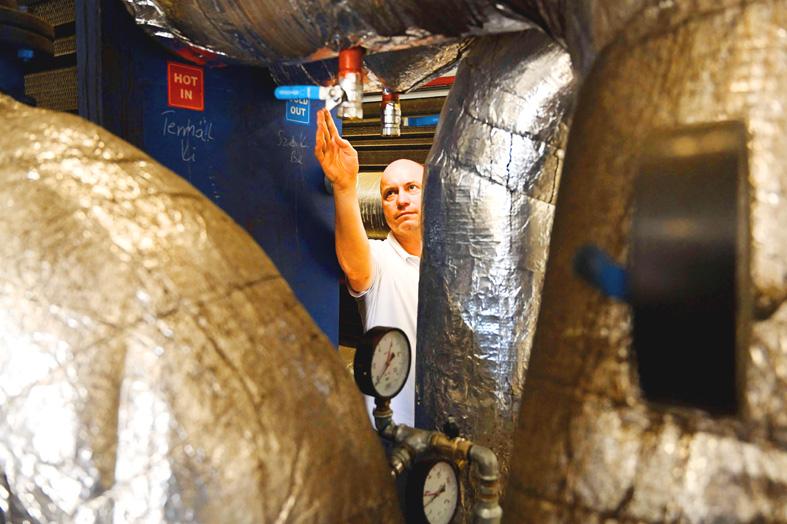At plants painted with birds and hedgehogs, hot water from deep underground is being channeled to produce energy and heat for thousands of households in Szeged, Hungary’s third-largest city.
Experts say the project — billed as Europe’s biggest urban heating system overhaul — can serve as a model for other cities across the continent, as EU nations scramble to wean themselves off Russian gas after Moscow’s invasion of Ukraine.
“Geothermal energy is local, accessible and renewable so why not use it,” geologist Tamas Medgyes told Agence France-Presse (AFP) beside a recently completed well in the middle of a residential neighborhood.

Photo: AFP
The city of 160,000 people, about 170km south of Budapest, is one of 12 in the landlocked central European country with geothermal district heating.
When the system is fully built out next year, 27 wells and 16 heating plants are to push geothermally heated water through 250km of pipes to heat 27,000 housing units and 400 nonresidential consumers.
This would make it Europe’s biggest geothermal urban heating system outside of Iceland.
However, unlike in the Icelandic capital, Szeged’s heating systems were built to run on gas.
EU member Hungary covers 65 percent of its oil needs and 80 percent of its gas needs with imports from Russia.
“This housing project was built in the 1980s. Since then we have burnt millions of cubic meters of imported Russian gas to heat cold water in these apartments,” Medgyes said.
However, now “we drilled down and got the hot water beneath our feet,” he said about the project, whose cost of more than 50 million euros (US$50.9 million) is partly covered by EU funds.
He added that the project can be a “blueprint” for cities in parts of France, Germany, Italy or Slovakia that are rich in geothermal deposits.
Experts says geothermal energy is an underutilized source of renewable heat in Europe.
“The geothermal urban heating development in Szeged is an easy-to-adopt example in many regions of Europe,” said Ladislaus Rybach, an expert at the Institute of Geophysics in Zurich, Switzerland.
Lajos Kerekes, a research associate at the Regional Centre of Energy Policy Research, told AFP that more than 25 percent of the EU’s population lives in areas suitable for geothermal district heating.
Long before the Ukraine war, Balazs Kobor, a director at Szeged heating firm Szetav, began exploring how cities can use geothermal energy and “knocking on doors of decisionmakers.”
In 2015, the city appointed him and Medgyes to initiate the integration of renewable energy sources into district heating.
“To heat the city annually the firm was burning 30 million cubic meters of gas and producing around 55,000 tonnes of carbon emissions every year,” Kobor said. “The city itself was its biggest carbon emitter.”
Kobor said that replacing gas by geothermal energy would slash the city’s annual greenhouse gas emissions by 60 percent — or about 35,000 tonnes.
If similar small to medium-sized cities switched their district heating to geothermal energy, it would be “a major step toward a carbon neutral, sustainable Europe,” he said.
Surrounded by the Carpathian and Alps mountain ranges, Hungary — and especially the area around Szeged — forms a basin where 92°C to 93°C hot water collects as deep as 2,000m below ground.
In facilities adjacent to the wells, “heat exchangers” comprising hundreds of metal panels transfer the heat to water in pipeline circuits that serve separate neighborhoods.
The geothermal water itself does not enter the circuits, but re-enters the earth through a “reinjection” well nearby, Medgyes said.
In another neighborhood, a noisy drill is gradually working its way deeper and deeper into the ground, adding sections of pipe as it goes.
The drilling period takes about three months, Medgyes said.
While residents can see and hear the drills as they work, after the work is done, they do not notice the change of heat source in their homes.
“The radiators and tap water are as warm as before. I don’t feel any difference,” Gabriella Maar Pallo, a 50-year-old clerk, told AFP in her nearby apartment.

Kehinde Sanni spends his days smoothing out dents and repainting scratched bumpers in a modest autobody shop in Lagos. He has never left Nigeria, yet he speaks glowingly of Burkina Faso military leader Ibrahim Traore. “Nigeria needs someone like Ibrahim Traore of Burkina Faso. He is doing well for his country,” Sanni said. His admiration is shaped by a steady stream of viral videos, memes and social media posts — many misleading or outright false — portraying Traore as a fearless reformer who defied Western powers and reclaimed his country’s dignity. The Burkinabe strongman swept into power following a coup in September 2022

‘FRAGMENTING’: British politics have for a long time been dominated by the Labor Party and the Tories, but polls suggest that Reform now poses a significant challenge Hard-right upstarts Reform UK snatched a parliamentary seat from British Prime Minister Keir Starmer’s Labor Party yesterday in local elections that dealt a blow to the UK’s two establishment parties. Reform, led by anti-immigrant firebrand Nigel Farage, won the by-election in Runcorn and Helsby in northwest England by just six votes, as it picked up gains in other localities, including one mayoralty. The group’s strong showing continues momentum it built up at last year’s general election and appears to confirm a trend that the UK is entering an era of multi-party politics. “For the movement, for the party it’s a very, very big

ENTERTAINMENT: Rio officials have a history of organizing massive concerts on Copacabana Beach, with Madonna’s show drawing about 1.6 million fans last year Lady Gaga on Saturday night gave a free concert in front of 2 million fans who poured onto Copacabana Beach in Rio de Janeiro for the biggest show of her career. “Tonight, we’re making history... Thank you for making history with me,” Lady Gaga told a screaming crowd. The Mother Monster, as she is known, started the show at about 10:10pm local time with her 2011 song Bloody Mary. Cries of joy rose from the tightly packed fans who sang and danced shoulder-to-shoulder on the vast stretch of sand. Concert organizers said 2.1 million people attended the show. Lady Gaga

SUPPORT: The Australian prime minister promised to back Kyiv against Russia’s invasion, saying: ‘That’s my government’s position. It was yesterday. It still is’ Left-leaning Australian Prime Minister Anthony Albanese yesterday basked in his landslide election win, promising a “disciplined, orderly” government to confront cost-of-living pain and tariff turmoil. People clapped as the 62-year-old and his fiancee, Jodie Haydon, who visited his old inner Sydney haunt, Cafe Italia, surrounded by a crowd of jostling photographers and journalists. Albanese’s Labor Party is on course to win at least 83 seats in the 150-member parliament, partial results showed. Opposition leader Peter Dutton’s conservative Liberal-National coalition had just 38 seats, and other parties 12. Another 17 seats were still in doubt. “We will be a disciplined, orderly